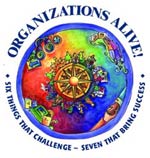
- About the MBTI
- Verify Your MBTI Type
- Personality Patterns
- MBTI Articles & Resources
- Article Directory for Educators & Students
- Books on Personality Types
- Emotional Intelligence & Personality Type
- Career Planning & MBTI
- MBTI Business Applications
- Lenore Thomson - Carl Jung Personality Type
- Site Map - Master Directory of All Articles
- MBTI Consultant Links
- Personality Type Workshops & Conferences
- Links to Other Type Websites
- Murder Mystery Business Theatre
- About Us
| 1 | 2 |
Articles on MBTI ® applications and Personality Type
 About Jan Yuill |
The following article by Canadian organizational development consultant Jan Yuill introduces a model of organizational intervention that is based on the Jung-Myers-MBTI ® typology of personality (psychological types). The model was developed in the course of her 30 years of experience working as a group facilitator, management trainer, and organizational development consultant. Her recent book - "Organizations Alive!" - offers an indepth look into how to use this model to enhance organizational change. Jan's Website. |
Jung and Healthy Organizations:
A Powerful Model for Change Agents
Jan Yuill, INFJ - Ottawa, Ontario, Canada
I got off the phone with an organization development (OD) consultant. He asked me about an upcoming workshop being offered in Ottawa (Ontario, Canada), entitled, The Individuation of the Organization. "I would like some more information,” he said.
I get this request a lot. For the past two years, most of my work has had something to do with the model described in my book, Organizations Alive!, and how it can be used to create more vibrant and remarkable organizations. I love to give more information! I am an introvert, who has spent years studying and working with organizations, using the lens of Jung’s four mental functions. Having gone very deeply into the subject, I am happy to tell more!
Somewhere in these conversations, you may hear me say, “If Jung were alive today, he’d probably be on OD consultant.” And I strongly believe that. I think he would have a great deal to say about people – in relationships, in teams, in organizations, and in society. I think he would be encouraging us to value differences, to seek understanding, to work well together, and to prosper.
Many events of the past few years -- terrorist activity, wars, environmental crises, insider trading, whistle blowing, high tech crashes -- have shown us that we need a new way of thinking about organizations. Managers, leaders, and other champions of change, are being blind-sided at every turn. The things that we believe could never happen do happen.
How is it that some organizations succeed so well at accomplishing their mission, while, for others, success remains an elusive dream? Why are our fine, traditional institutions – schools, hospitals, governments, etc. – struggling so? How is it that on one day a company can demonstrate to stakeholders that it is in the black, and the next it is in the throws of scandal and bankruptcy?
Carl Jung gave us the building blocks for understanding what is going on.
A Quick Tour of Organizations Alive!,
The Organizations Alive! model uses familiar business terms, rather than those of personality type. For the professional who uses personality type, the parallels to Jung’s theory will be obvious. But it makes good sense to those who know nothing of typology or temperament, as well.
Information gathering and decision-making are two fundamental processes of organizations, as well as people. They are as constant as breathing.
-
The information may be of a macro or big picture nature (Jung’s Intuition), or micro and specific (Sensing).
-
Decision-making may be objective and task-oriented (Thinking), or subjective and focused on people (Feeling).
These four functions can be arranged in Jung’s ‘+’ shape as shown in the diagram below.
The combinations of these create four very distinct functions in organizations. They are domains that are hugely important, but tend to compete, even negate the importance of the other, unless there is a consciousness about those dynamics.
-
I call the macro-task quadrant Strategic Vision. It is the broad brush strokes (macro) of the work (task) of organizations, and includes such things as mandate, mission, the business plan, long-range goals, its agenda (political, financial, social, etc.), the principals that it operates under, legislation and bylaws, and the latest trends, research, and theory that concern the work of the organization.
-
The micro-task quadrant is called Resource Management. It is the specific handling of details (micro) associated with the work (task) of the organization and includes:
-inputs (raw materials, buildings, vehicles, equipment, supplies, money, technology, knowledge, documents, communications media, etc.)
-throughputs (systems and processes, methods, production, roles and responsibilities, policy and procedures, operations, etc.)
-outputs (goods and services for the customer/consumer/client)In the Resource Management quadrant, activities and things are measured, counted, weighed, controlled, calculated, filed, maintained, monitored, manufactured, packaged, shipped, handled, protected, written, flowcharted, etc. etc.
-
The third domain is about the micro-people combination, and is called Customer Service. It is the very specific details (micro) as they are received and perceived by the organization’s customers (people). This is where a transaction takes place. Someone receives something, the details of which may include size, quantity, colour, timeliness, convenience, quality, value for money, features, etc. etc. And successful organizations know that it is, not their view of whether or not the customer has been adequately served, but the customer’s own view that matters.
-
I call the macro-people quadrant Membership Potential. It concerns the possibilities (macro) of the members (people) of the organization. It includes all the expertise, knowledge, gifts, skills, experience, motivations, desires, goals, beliefs, values, etc. that make up each individual. It is a huge reservoir of talent, energy, and ideas for organizations to tap.
Organizational success is determined by how well these four domains, which I call Success Factors, are understood and balanced, a process Jung may have referred to as organizational individuation. Difficulties arise when any of them are over- or underemphasized. And yet, balance is never a perfect or permanent state. It takes ongoing, conscious, and persistent effort on the part of leaders, managers, and every person in the organization who want to have a positive impact.
> > > Next Page: The Four Success Factors and the Six Interfaces
® MBTI, Myers-Briggs, Meyers Briggs, and Myers-Briggs Type Indicator are registered trademarks or trademarks of the Myers-Briggs Type Indicator Trust in the United States and other countries (aka meyers briggs or myers briggs).
ORGANIZATIONS ALIVE!
SIX THINGS THAT CHALLENGE ~ SEVEN THAT BRING SUCCESS
JAN YUILL
Yuill & Associates, Ottawa, Ontario
$18.95 CDN ($14.95 US), paperback, (110p)
ISBN: 0-9734207-0-7
Organizations Alive! is full of real-life examples, with tools and processes to help with its application in any organization, whether government, private sector, or not-for-profit. For more information -- testimonials, the preface of the book, book reviews, and how to obtain your copy – go to www.OrganizationsAlive.com.
![]()
Go Here to Learn more about Personality Type and Leadership Development
© Published by Ross Reinhold & Reinhold Development 1997 - 2023
Privacy Policy About Us


